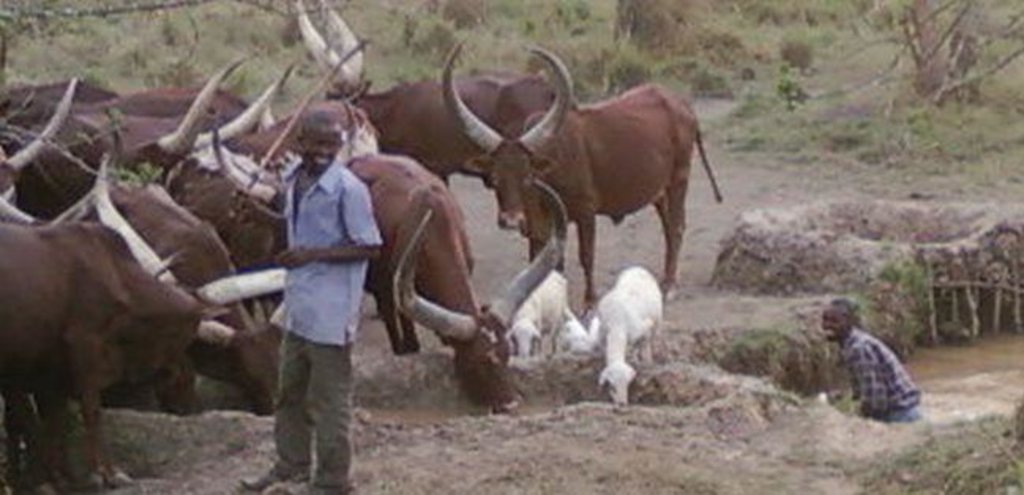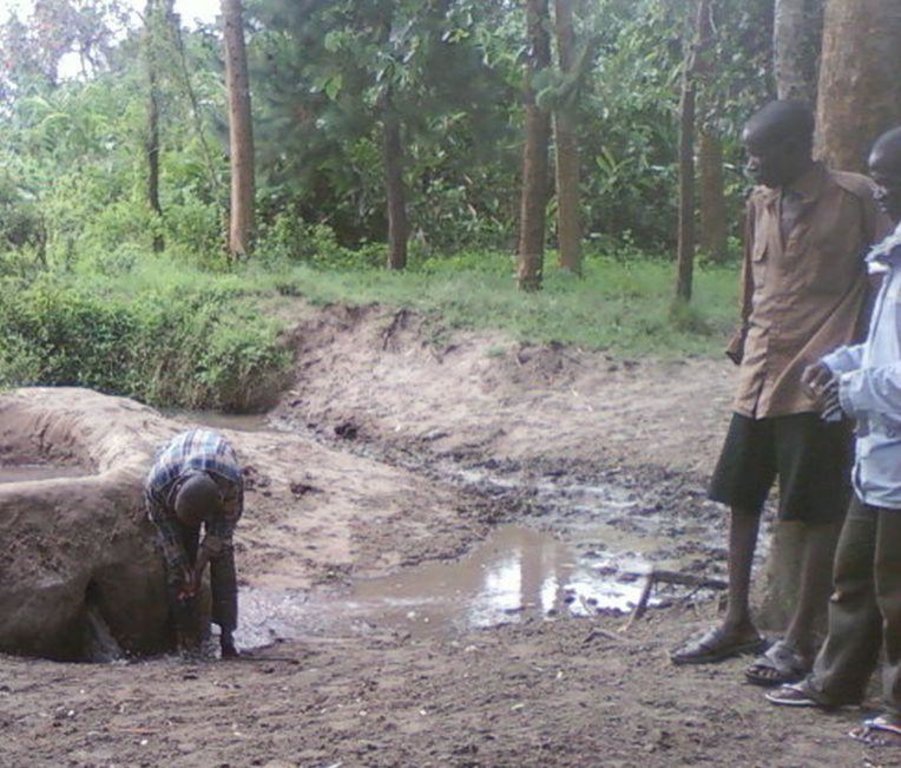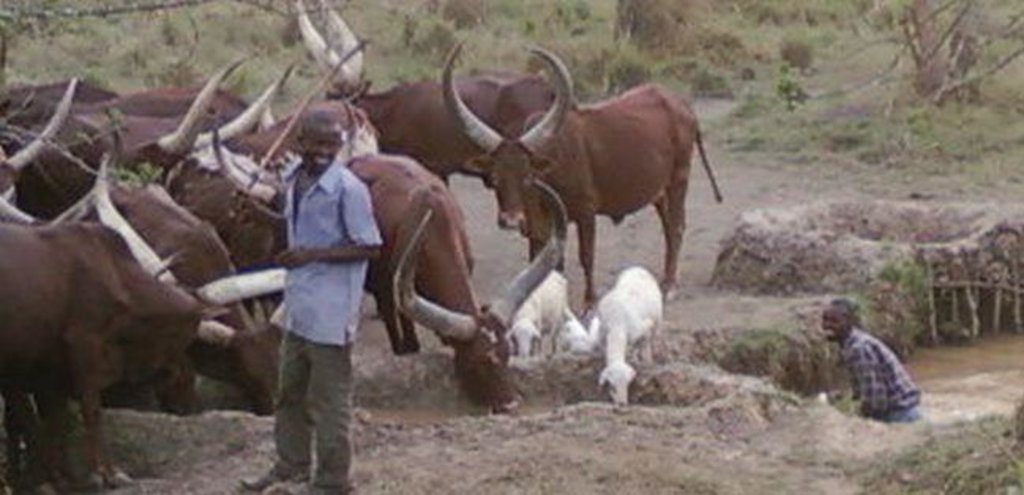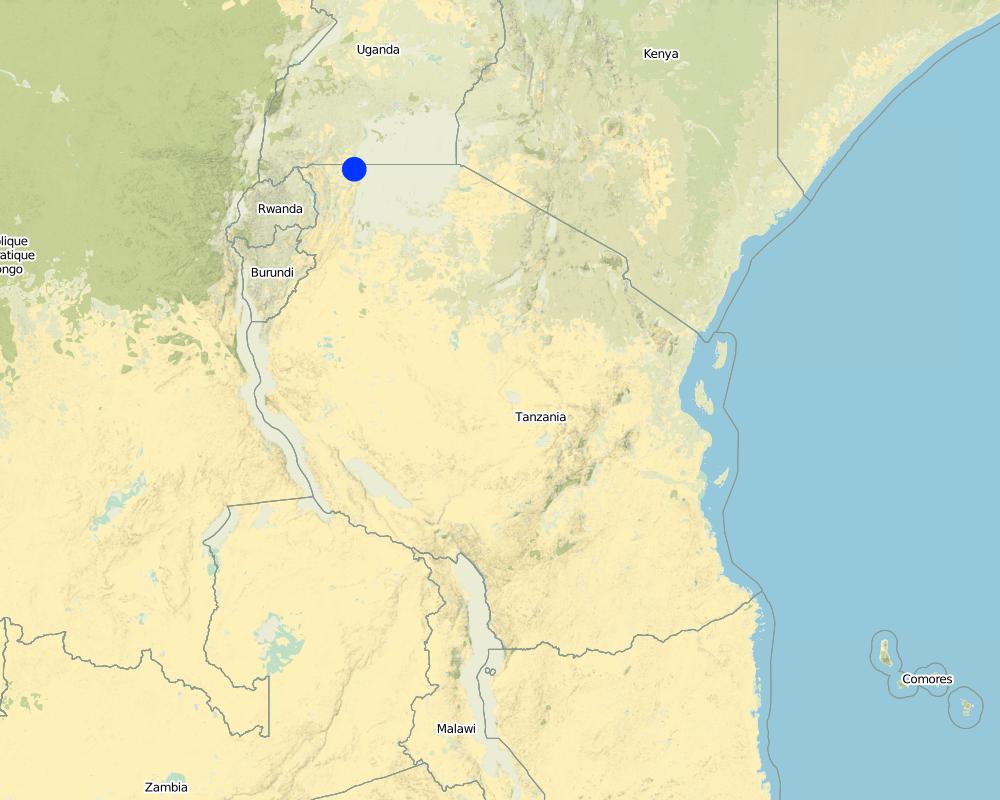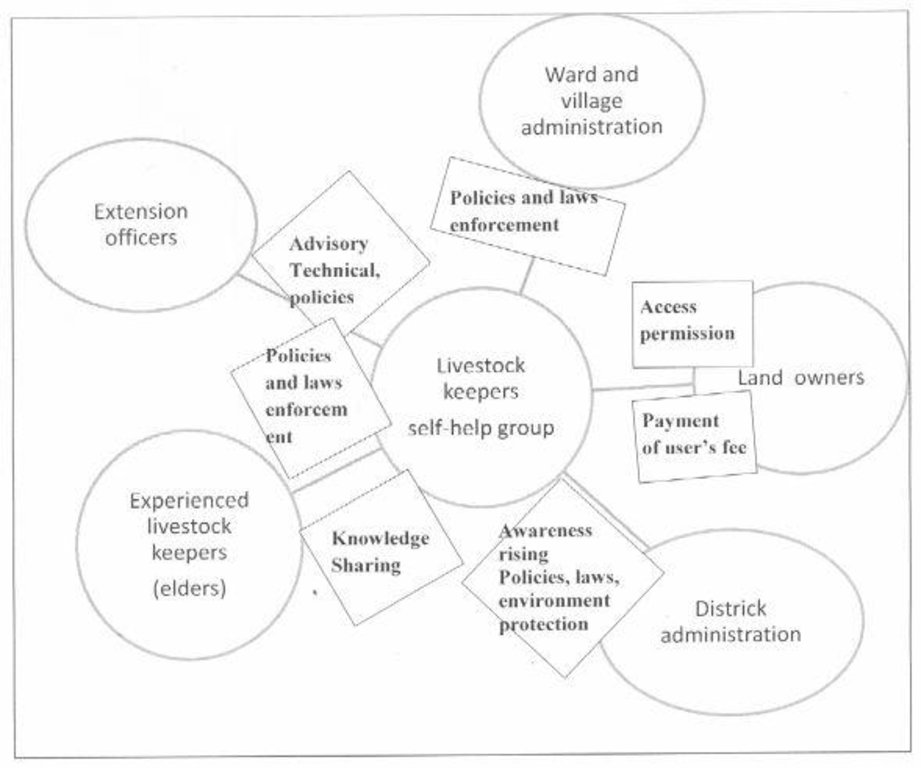Livestock keepers initiative for continued dry season animal drinking water supply [تنزانيا، جمهورية تنزانيا المتحدة]
- تاريخ الإنشاء:
- تحديث:
- جامع المعلومات: ALLAN BUBELWA
- المحرر: –
- المُراجع: Fabian Ottiger
Emigilile ya abatungi b’ente oyokueshela ente
approaches_2589 - تنزانيا، جمهورية تنزانيا المتحدة
عرض الأقسام
توسيع الكل طي الكل1. معلومات عامة
1.2 تفاصيل الاتصال بالأشخاص الرئيسيين لمصدر المعلومات والمؤسسات المعنية بتقييم وتوثيق النهج
متخصص في الإدارة المستدامة للأراضي:
متخصص في الإدارة المستدامة للأراضي:
متخصص في الإدارة المستدامة للأراضي:
Subira John
Missenyi district council
تنزانيا، جمهورية تنزانيا المتحدة
متخصص في الإدارة المستدامة للأراضي:
Kagaruki Annagrace
Missenyi district council
تنزانيا، جمهورية تنزانيا المتحدة
متخصص في الإدارة المستدامة للأراضي:
Kitundu Elizabeth
+255 0732983531,
missenyicouncil@yahoo.com
Missenyi District Council
Box 38 Kyaka Missenyi Kagera
تنزانيا، جمهورية تنزانيا المتحدة
متخصص في الإدارة المستدامة للأراضي:
Kaihura Fidelis
National Project Manager
تنزانيا، جمهورية تنزانيا المتحدة
اسم المشروع الذي سهّل توثيق/تقييم النهج (إذا كان ذلك على صلة)
The Transboundary Agro-ecosystem Management Project for the Kagera River Basin (GEF-FAO / Kagera TAMP )اسم المؤسسة (المؤسسات) التي سهلت توثيق/تقييم النهج (إذا كان ذلك على صلة)
Food and Agriculture Organization of the United Nations (FAO) - إيطاليااسم المؤسسة (المؤسسات) التي سهلت توثيق/تقييم النهج (إذا كان ذلك على صلة)
Missenyi District Council (Missenyi District Council) - تنزانيا، جمهورية تنزانيا المتحدة1.3 الشروط المتعلقة باستخدام البيانات الموثقة من خلال WOCAT
متى تم تجميع البيانات (ميدانيا)؟:
28/08/2012
يوافق جامع المعلومات والشخص (لاشخاص) الرئيسي لمصدر المعلومات على الشروط المتعلقة باستخدام البيانات الموثقة من خلال WOCAT:
نعم
1.4 المراجع الخاصة باستبيان(استبيانات) تقنيات الإدارة المستدامة للأراضي
2. وصف نهج الإدارة المستدامة للأراضي
2.1 وصف موجز للنهج
Livestock keepers groups and local government collaboration for management of livestock watering points.
2.2 وصف تفصيلي للنهج
وصف تفصيلي للنهج:
Aims / objectives: The main aim of this approach is to improve management of water resources through strengthening collaboration between land owners and livestock keepers for efficient livestock production/management and increased incomes. This approach ensures livestock watering point accessibility during dry seasons. Objective is to reach a compromise between livestock keepers and land owners on terms of conditions for access and use of watering points. As results livestock keepers and land owner can improve their planning activities and minimize conflict between them.
Methods: A self-help livestock keepers group is normally formed. It establishes regular and efficient cooperation among the livestock keepers and negotiations with land owners on water access issues. They make financial contributions to support the established self-help group. Through these contributions construction and maintenance of the ponds and troughs (the livestock watering system) is assured. Construction and maintenance is also done through voluntary work.
This traditional system was developed by elders and spread through learning by doing from the old to the young generation. In passing over knowledge from the elderly to the youths, experience in livestock and water resources management systems is gained.
The approach is also characterized by reverence to the existing village by-laws reinforced by the village government as well as existing customary laws to prevent degradation and pollution of water sources. Extension officers provide technical backstopping on recommended animal health practices that include deworming, routine spraying and vaccination against diseases.
Stages of implementation: Implementation takes place in three stages
1) Livestock keeper group formation: The group size is determined by the number of livestock. A single trough can accommodate not more than 150 cattle which determine the number of livestock keepers to form a group. The group has its informal organizational system with a nominated leader.
2) Contributions and voluntary works: Each livestock keeper makes a payment of about 20 dollars to the land owner as annual user fee. Maintenance is the responsibility of all livestock keepers.
3) Management: Include use of by-laws and provision of advisory services
Role of stakeholders: Land owner: He has the key role of ensuring that the area is used in a sustainable manner. Group members pay land rent to him for area utilization and management.
Livestock keepers: These are key users of the area, voluntarily participate in construction and maintenance of water troughs, pay land rent, manage and control watering of their animals.
Village and Ward administration and elders: Ensuring that village by-laws and customary laws guiding use of fragile ecosystems are adhered to.
Ward and village extension officers: Provide technical advisory to livestock keepers.
District administration and extension staff: Facilitating and enabling community understanding of policy, acts and laws guiding use of fragile ecosystems so that they can make informed management decision.
Other important information: This approach plays significant role in preventing conflict between domestic water users and livestock keepers especially during the dry season.
2.3 صور عن النهج
2.5 البلد/المنطقة/المواقع التي تم تطبيق النهج فيها
البلد:
تنزانيا، جمهورية تنزانيا المتحدة
المنطقة/الولاية/المحافظة:
TANZANIA
مزيد من التفاصيل حول الموقع:
MISSENYI
Map
×2.7 نوع النهج
- تقليدي/أصلي
2.8 الغايات/الأهداف الرئيسية للنهج
The Approach focused mainly on SLM with other activities (Construction, managment and utilization)
Minimizing of land dagradation and better water availability to contribute to livelihood improvement.
The SLM Approach addressed the following problems: 1. There was no livestock keepers organization to comprise over use of water resource during the dry season.
2. Water use conflict between livestock keepers and domestic water users
3. Weak administration of bylaws.
2.9 الظروف التي تمكن أو تعيق تنفيذ التقنية/التقنيات المطبقة بموجب النهج
المعايير والقيم الاجتماعية /الثقافية/ الدينية
- معيق
Traditionally livestock keepers keep large herds for prestige.
Treatment through the SLM Approach: Livestock keeper with large herds are advised to reduce number of animals by selling extra animals and use funds for intensifying management and maximizing productivity.
توفر/الوصول إلى الموارد والخدمات المالية
- معيق
Livestock keepers are not aware of the services provided by financial institutions and are ignorant of the basic bookkeeping skills.
Treatment through the SLM Approach: Sensitized livestock keepers on utilization of financial institutions and provide training in the basic bookkeeping skills.
الإطار المؤسساتي
- معيق
Livestock keepers informally organized but not legally recognized; the groups are not registered and have no written constitution.
Treatment through the SLM Approach: Livestock keeper advised to strengthen their groups/organization through registration by relevant authorities and establish a written group constitution.
الإطار القانوني (حيازة الأراضي، وحقوق استخدام الأراضي والمياه)
- معيق
Ignorance of livestock keepers on the Act, Laws and Rules governing the use of fragile ecosystems.
Treatment through the SLM Approach: Extension workers enabling and facilitating community understanding of policy and acts guiding use of fragile ecosystems.
المعرفة حول الإدارة المستدامة للأراضي، والوصول إلى الدعم الفني
- معيق
Low knowledge on recommended livestock rearing practises and water borne diseases.
Treatment through the SLM Approach: Training livestock keepers on recommended livestock rearing practices, prevention and controll of water borne diseases as well as water hygine and sanitation.
عبء العمل، توفر القوى العاملة
- معيق
High work load needed in filling of the water troughs
Treatment through the SLM Approach: Livestock keepers advised to use water pumping machines (simple and manually operated machines).
3. المشاركة وأدوار الأطراف المعنية
3.1 أصحاب المصلحة المعنيون بالنهج وأدوارهم
- مستخدمو الأراضي المحليون/المجتمعات المحلية
Key implementer and user of the SLM approach, the land owner and the livestock keepers
Traditionally grazing stocks (cattle, sheep and goats) are owned and reared by men and therefore the approach mainly involves men. The roles area largely men specific.The approach also targeted low income livestock owners (casual cattle herds man).
- متخصصون في الإدارة المستدامة للأراضي / مستشارون زراعيون
District, ward and village extension officers
- الحكومة المحلية
Provision of technical advisory services, policy and act interpretation and reinforcement of village bylaws.
- الحكومة الوطنية (المخططون، صانعو القرار)
Village and Ward elected and employed representatives.
3.2 انخراط مستخدمي الأراضي المحليين/المجتمعات المحلية في المراحل المختلفة للنهج
| انخراط مستخدمي الأراضي المحليين/المجتمعات المحلية | حدد من شارك وصف الأنشطة | |
|---|---|---|
| المبادرة/التحفيز | التعبئة الذاتية | Livestock keepers /elders: Inheritance and transference of the approach to youth. |
| التخطيط | التعبئة الذاتية | Livestock keepers /elders: Informal planning and improvement through cycles of action and reflection. |
| التنفيذ | التعبئة الذاتية | Livestock keepers individuals and groups, village leaders and agricultural advisers: use of the approach, law enforcement and technical advisory services and interpretation of act, law and guidelines protecting fragile ecosystems. |
| الرصد/التقييم | التعبئة الذاتية | Livestock keepers individuals and groups, village leaders and agricultural advisers and SLM specialists: manage effective use of the technology, ensure adherence of Acts, Rules and Regulation and SLM documentation for dissemination and sharing. |
| Research | تفاعلي | Livestock keepers individuals and groups and agricultural advisers and SLM specialists: identification and documentation of researchable issues. |
3.3 مخطط التدفق (إذا كان متاحًا)
الوصف:
Livestock keepers initiative for continued dry season animal drinking water supply.
المؤلف:
Allan Bubelwa (Box 38 Kyaka, Missenyi, Kagera, United Tanzania)
3.4 اتخاذ القرار بشأن اختيار تقنية/تقنيات الإدارة المستدامة للأراضي
حدد من الذي قرر اختيار التقنية/التقنيات التي سيتم تنفيذها:
- مستخدمو الأراضي وحدهم (المبادرة الذاتية)
اشرح:
A decision to use the technology relies on livestock keepers self-mobilization, own choice induced through inheritance and learning by doing.
Decisions on the method of implementing the SLM Technology were made by by land users* alone (self-initiative / bottom-up). Decision to use the method is partly through spontaneous adoption from elders and improvement through cycles of action and reflection.
4. الدعم الفني وبناء القدرات وإدارة المعرفة
4.1 بناء القدرات/التدريب
هل تم تقديم التدريب لمستخدمي الأراضي / الأطراف المعنيين الآخرين؟:
نعم
حدد من تم تدريبه:
- مستخدمو الأراضي
- موظفون ميدانيون/ مستشارون
- village and ward leaders
إذا كان ذلك على صلة، حدد الجنس والعمر والوضع والعرق وما إلى ذلك.
both men and women and all ages (youth and elders).
شكل التدريب:
- في العمل
- اجتماعات عامة
شكل التدريب:
- seminar and workshops.
المواضيع المغطاة:
Act and Laws guiding the use of fragile ecosystems, prevention of water borne diseases, recommended livestock keeping methods and water management.
4.2 خدمة استشارية
هل يملك مستخدمو الأراضي وصولا إلى خدمة استشارية؟:
نعم
حدد ما إذا كانت الخدمة الاستشارية متوفرة:
- في حقول مستخدمي الأراضي
وصف/تعليقات:
Name of method used for advisory service: Farmer field school ; Key elements: learning by doing on the job and in the field (Number of knowledge sharing activities: on the job training, field practice), adult learning – livestock self-help groups , livestock management. , indegenous and technical knowledge balanced and combined in a complementary manner.; Technical advisory services largely involved building on and improving the successful experience resulted from the use of indigenous knowledge.
Advisory service is quite adequate to ensure the continuation of land conservation activities; The increase number of extension workers from 1 to 2 and introduction of TAMP project (trans boundary agro-ecosystem management project) in the village will speed up implementation of conservation activities in the village.
4.3 تعزيز المؤسسات (التطوير التنظيمي)
هل تم إنشاء أو تعزيز مؤسسات من خلال هذا النهج؟:
- لا
4.4 الرصد والتقييم
هل يشكل الرصد والتقييم جزءا من النهج؟:
نعم
التعليقات:
bio-physical aspects were ad hoc monitored by government, land users through observations; indicators: extent of area eroded
bio-physical aspects were ad hoc monitored by government, land users through measurements; indicators: Ponds/troughs and maintenance requirements
technical aspects were ad hoc monitored by land users through observations; indicators: number of livestock keeper trained
technical aspects were ad hoc monitored by land users through measurements; indicators: number of conflicts between land owners and livestock keepers
socio-cultural aspects were ad hoc monitored by land users through observations; indicators: number of water conflict emerged and number resolved
socio-cultural aspects were ad hoc monitored by government, land users through measurements; indicators: livestock production and productivity
economic / production aspects were regular monitored by government through observations; indicators: increase in milk and meat productivity
economic / production aspects were regular monitored by government, land users through measurements; indicators: livestock keepers using the technology
no. of land users involved aspects were regular monitored by government, land users through observations; indicators: number of livestock keepers using the technology
no. of land users involved aspects were regular monitored by government, land users through measurements; indicators: adherence to water protective bylaws
management of Approach aspects were regular monitored by government through observations; indicators: % number of village bylaws used and adhered to
management of Approach aspects were regular monitored by government through measurements; indicators: None
There were few changes in the Approach as a result of monitoring and evaluation: Implementation of group roles and adherence to by-laws e.g. protection of natural vegetation.
There were few changes in the Technology as a result of monitoring and evaluation: decrease in destruction of natural vegetation and reduction of eutrophication at the water source.
4.5 البحوث
هل كانت البحوث جزءًا من النهج؟:
نعم
- adaptive SLM trials
أعط تفاصيل إضافية وأشر إلى من قام بالبحوث:
Adaptive trials through SLM demos by TAMP, ARI MARUKU and community. Farmers select the best bets technologies to apply on their own fields.
Research was carried out on-farm
5. التمويل والدعم المادي الخارجي
5.1 الميزانية السنوية لمكون الإدارة المستدامة للأراضي في النهج المذكور
إذا لم تكن الميزانية السنوية الدقيقة معروفة، قم بالإشارة إلى نطاقها:
- < 2000
التعليقات (على سبيل المثال المصادر الرئيسية للتمويل/الجهات المانحة الرئيسية):
Approach costs were met by the following donors: local government (district, county, municipality, village etc) (animal related extesion services, policy and law enforcement.): 20.0%; local community / land user(s) (voluntary contribution by livestock keeper groups and land owner ): 80.0%
5.2 الدعم المالي/المادي المقدم لمستخدمي الأراضي
هل حصل مستخدمو الأراضي على دعم مالي/ مادي لتنفيذ التقنية/ التقنيات؟:
كلا
5.3 إعانات لمدخلات محددة (بما في ذلك العمالة)
إذا كان العمل من قبل مستخدمي الأراضي مدخلاً جوهريًا، فهل كان:
- تطوعي
التعليقات:
labour is needed in taking the animals for watering as well as during actual watering of the animals.
5.4 الائتمان
هل تم توفير ائتمان في إطار نهج أنشطة الإدارة المستدامة للأراضي؟:
كلا
6. تحليل الأثر والتصريحات الختامية
6.1 آثار النهج
هل ساعد النهج مستخدمي الأراضي على تنفيذ وصيانة تقنيات الإدارة المستدامة للأراضي؟:
- لا
- نعم، قليلا
- نعم، باعتدال
- نعم، إلى حد كبير
This approach plays significant role in reducing conflict between domestic water users, increased availability of water and conservation of water resources.
هل ساهم النهج في تمكين الفئات المحرومة اجتماعيا واقتصاديا؟:
- لا
- نعم، قليلا
- نعم، باعتدال
- نعم، إلى حد كبير
The approach enables low income-cattle herd man to earn income.
Did other land users / projects adopt the Approach?
- لا
- نعم، قليلا
- نعم، باعتدال
- نعم، إلى حد كبير
other livestock group adopted the approach (in dry season).
Did the Approach lead to improved livelihoods / human well-being?
- لا
- نعم، قليلا
- نعم، باعتدال
- نعم، إلى حد كبير
Livestock keepers that joined self-help groups improved livestock productivity and increased income
Did the Approach help to alleviate poverty?
- لا
- نعم، قليلا
- نعم، باعتدال
- نعم، إلى حد كبير
year round availability of water for animals, increased animal production and productivity and income to livestock keepers and improve rural socio-economic conditions.
6.2 المحفز الرئيسي لقيام مستخدمي الأراضي بتنفيذ الإدارة المستدامة للأراضي
- زيادة الإنتاج
improved animals heath and increased production
- القواعد واللوائح (الغرامات) / الإنفاذ
rules preventing livestock keepers from watering their animals in domestic water sources
- الوعي البيئي
developed through various SLM trainings provided by extension officers.
6.3 استدامة أنشطة النهج
هل يمكن لمستخدمي الأراضي المحافظة على استدامة ما تم تنفيذه من خلال النهج (بدون دعم خارجي)؟:
- غير مؤكد
إذا كان الجواب لا أو غير متأكد، حدد ذلك وعلق عليه:
in the future a support is needed in terms of group management and organizational development, marketing and business planning skills and livestock keepers also need further exposure to SLM concept.
6.4 نقاط قوة/مزايا النهج
| نقاط القوة/ المزايا/ الفرص من وجهة نظر مستخدمي الأراضي |
|---|
| Is a mechanism for assurance of water availability for animal watering in the dry season. (How to sustain/ enhance this strength: continue with good collaboration with the land owner and livestock keeper solidarity.) |
| نقاط القوة/ المزايا/ الفرص من وجهة نظر جامع المعلومات أو غيره من الاشخاص الرئيسيين لمصدر المعلومات |
|---|
| The training of extension officers, elders etc covered many aspects of sustainable livestock production and natural water resources protection (How to sustain/ enhance this strength: Activities presented during the training should be put into practice and spread among other livestock keepers ) |
| Involvement of the district administration, wards, elders in the approaches implementation (How to sustain/ enhance this strength: insist on active involvement ) |
| Strong commitment of livestock keepers to improve livestock production and their livelihood (How to sustain/ enhance this strength: Awareness raising ) |
| Reduced conflict between water for domestic use and for watering animals (How to sustain/ enhance this strength: strengthen use of the approach and bylaws guiding it ) |
| Reduced cost and largely relies on self mobilization and voluntarism of the livestock keepers. (How to sustain/ enhance this strength: Group management and organizational development to strengthen cohesiveness.) |
| Is dynamic, flexible and accommodate outside advisory and technical support and therefore opens opportunities for future improvement. (How to sustain/ enhance this strength: Needs assessment and provision of appropriate advisory and technical support. ) |
6.5 نقاط الضعف/ العيوب في المنهج وطرق التغلب عليها
| نقاط الضعف/ المساوىء/ المخاطر من وجهة نظر مستخدم الأراضي | كيف يمكن التغلب عليها؟ |
|---|---|
| low know how | broadern know how |
| نقاط الضعف/ المساوىء/ المخاطر من وجهة نظر جامع المعلومات أو غيره من الاشخاص الرئيسيين لمصدر المعلومات | كيف يمكن التغلب عليها؟ |
|---|---|
| The approach is largely informal in terms of livestock keepers organization. There is no written constitution and the groups are not registration. | improvement in terms of formulation of group constitution, opening of bank account and group registration. |
| Narrow focus largely relies solely on indigenous knowledge base . | broaden horizon of understanding by combining with technical knowledge base. |
| Lack of promotion materials to involve other livestock keepers | increase number of promotion materials |
| Rural poverty not reduced significantly | more activities that can lead to reduction of rural poverty required |
7. المراجع والروابط
7.1 طرق جمع/مصادر المعلومات
- زيارات ميدانية، مسوحات ميدانية
- مقابلات مع مستخدمي الأراضي
7.2 المراجع للمنشورات المتاحة
العنوان، المؤلف، السنة، النظام القياسي الدولي لترقيم الكتب ISBN:
Kagera TAMP project (pdfFinal Report 2013)
متاح من أين؟كم التكلفة؟:
http://www.fao.org/fileadmin/user_upload/oed/docs/GCPRAF424GFF_2013_ER.pdf
الروابط والوحدات المواضيعية
توسيع الكل طي الكلالروابط
لا يوجد روابط
الوحدات المواضيعية
لا يوجد وحدات مواضيعية



